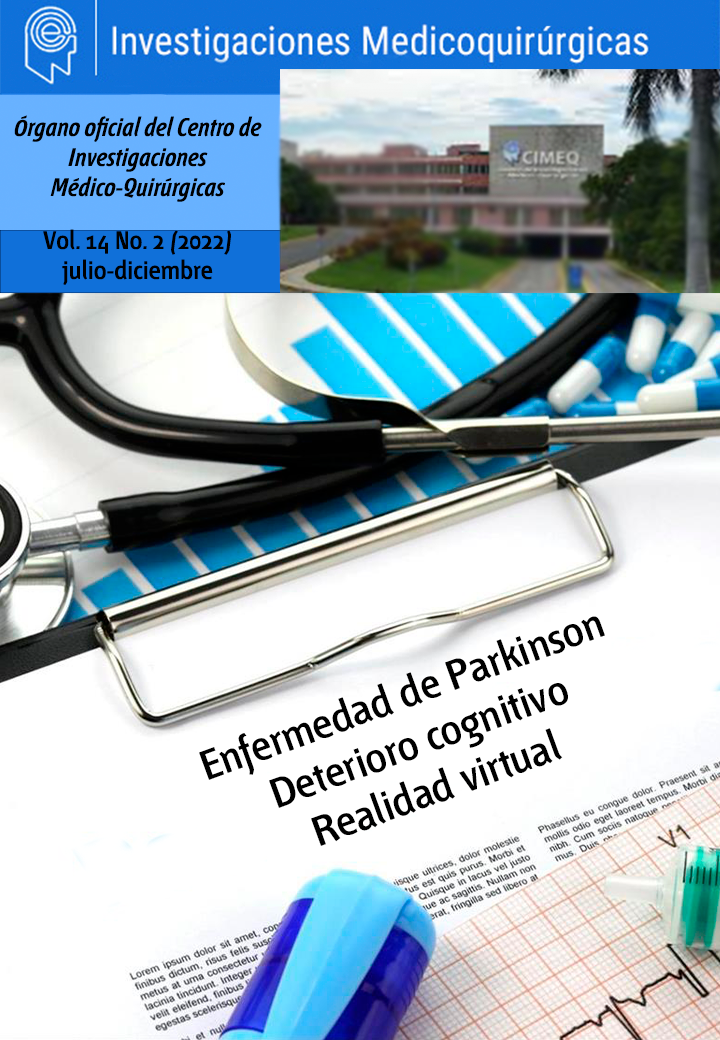Anti-VEGF, neovascular glaucoma and treatment
Keywords:
neovascular glaucoma, anti-vascular endothelial growth factor, Anti-VEGF, bevacizumabAbstract
Introduction: Neovascular glaucoma is the result of an ischemic insult to the retina of varied cause, with potentially devastating visual effect, straining current treatment strategies. To show the results of the application of anti-VEGF, associated with other treatment modalities.
Case Presentation: A prospective observational descriptive study was performed in patients at risk or diagnosed with VGN in 7 cases. Anti-VEGF therapy (Bevacizumab, intravitreal injection) was applied. Control of baseline disease, IOP, VAmc, and persistence of neovessels in the anterior segment were evaluated in each case.
Results: IOP improved in 5 cases; 2 cases improved AVmc, 3 cases stabilized it, 2 cases worsened it; 5 cases required PFR for remission of NVI and NVA; all cases required anti-glaucoma drugs and 2 cases were referred to anti-glaucoma surgery.
Conclusions: Anti-VEGF therapy is of great utility, as definitive treatment or associated with other therapeutic modalities in neovascular glaucoma.
References
Secondary Angle Closure Glaucoma without pupillary block. Neovascular Glaucoma. Angle Clsure Glaucoma. Basic and Clinical Science Course 2019-2020. Chapter 5. (p. 132-138).
Sivak-CallcottJA, O’Day DM, Gass JD, Tsai JC. Evidence-based recommendations for thediagnosis and treatment of neovascular glaucoma. Ophthalmology. 2001;108:1767-76.
Tah, V., et al., Anti-VEGF Therapy and the Retina: An Update. J Ophthalmol, 2015. 2015: p. 627674
Ferrara N. Vascular endothelial growth factor: basic science and clinical progress. Endocr Rev 2004; 25: 581-611.
Nguyen QD, Rodrigues EB, Farah ME, Mieler WF, Do DV (eds): Retinal Pharmacotherapeutics. Dev Ophthalmol. Basel, Karger, 2016, vol 55, pp 200-203 (DOI: 10.1159/000431196)
Sun Yaoyao et al., Anti-VEGF treatment is the key strategy for neovascular glaucoma management in the short term. Sun et al. BMC Ophthalmology (2016) 16:150 DOI 10.1186/s12886-016-0327-9.
Kim D, Singh A, Annapurna S. Neovascular Glaucoma. En: Shaarawy TM. Glaucoma Medical Diagnosis and Therapy. Saint Louis (EE.UU.): Saunders Elsevier; 2009. p. 409-17.
Ferrara N. Vascular endothelial growth factor: basic science and clinical progress. Endocr Rev 2004; 25: 581-611.
J.S Penn(ed.), Retinal and Choroidal Angiogenesis, 407–418. 2008.
Bakri SJ, Snyder MR, Reid JM, et al. Pharmacokinetics of intravitreal bevacizumab (Avastin®). Ophthalmology. 2007;114:855-9.
Vasconcellos JP, Costa VP, Kara-Jose N. Neovascular glaucoma: epidemiology and prognostic factors. Proposal of a flow chart to quideguide the treatment. Arq Bras Oftalmol. 1998;61(5):519–24.
Mecano A, Fernández Vigo J, Chacon J, Pemanent JF. Epidemiología del Glaucoma en la población Diabética. Arch Soc Esp Oftalmol 2003; 71: 151 - 58.
Xu Liang MD, Wang Ya, Xing MD, Jonas Jost B. Ocular Hypertension and Diabetes Mellitus in the Beijing Eye Study. Journal of Glaucoma 2009; 18(1):21-25.
Redondo Piñó L R et al, Glaucoma neovascular, complicación de la isquemia retiniana. Rev Cubana Endocrinol. 2016;27(1).ISSN1561-2953
Verdaguer J, Zanolli M, Sepúlveda G, García de los Ríos M, Domínguez A. Natural history of diabetic retinopathy in a retrospective cohort of type 1 diabetics. Rev Med Chil. 2009 Sep;137(9):1145-52.
Shazly TA, Latina MA. Neovascular Glaucoma: Etiology, Diagnosis and Prognosis. Inf Health Care [serie en Internet]. 2009 [citado 11 de diciembre de 2008];24(2). Disponible en: http://www.tandfonline.com/doi/abs/10.1080/08820530902800801
Martínez-Carpio Pa et al, Eficacia y seguridad de la inyección intravítrea de bevacizumab en el tratamiento del glaucoma neovascular: revisión sistemática. ARCH SOC ESP OFTALMOL 2008; 83: 579-588.
Gunther JB, Altaweel MM. Bevacizumab (Avastin) for the Treatment of Ocular Disease. Survey of Ophthalmology 2009; 54: 372-400.
Elgin U, Berker N, Batman A. Trabeculectomy with mitomycin C combined with direct cauterization of peripheral iris in the management of neovascular glaucoma. J Glaucoma 2006; 15: 466-470.
Downloads
Published
How to Cite
Issue
Section
License
The authors retain copyright and all unrestricted publication rights.
Medicoquirúrgicas Research is licensed under the Creative Commons Attribution-Noncommercial 4.0 International License (CC BY-NC 4.0) and follows the SciELO Publishing Schema (SciELO PS) for publishing in XML format.
You are free to:
- Share — copy and redistribute the material in any medium or format.
- Adapt — remix, transform, and build upon the material.
The license cannot revoke these freedoms as long as you follow the license terms.
Under the following terms:
- Attribution — You must give appropriate credit, provide a link to the license, and indicate if changes were made. You may do this in any reasonable manner, but not in any way that suggests the licensor endorses you or your use.
Non-Commercial — You may not use the material for commercial purposes.
No Additional Restrictions — You may not apply legal terms or technological measures that legally restrict others from making any use permitted by the license.
Notices:
You do not have to comply with the license for elements of the material in the public domain or where their use is permitted by an applicable exception or limitation.
No warranties are given. The license may not give you all the permissions you need for your intended use. For example, other rights such as publicity, privacy, or moral rights may limit how you use the material.



